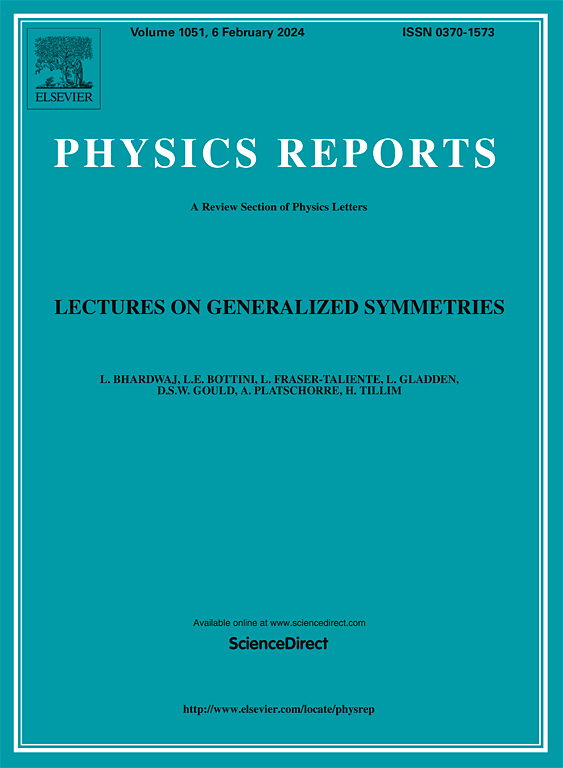Overview of high-density QCD studies with the CMS experiment at the LHC
IF 29.5
1区 物理与天体物理
Q1 PHYSICS, MULTIDISCIPLINARY
引用次数: 0
Abstract
We review key measurements performed by CMS in the context of its heavy ion physics program, using event samples collected in 2010–2018 with several collision systems and energies. These studies provide detailed macroscopic and microscopic probes of the quark-gluon plasma (QGP) created at the LHC energies, a medium characterized by the highest temperature and smallest baryon-chemical potential ever reached in the laboratory. Numerous observables related to high-density quantum chromodynamics (QCD) were studied, leading to some of the most impactful and qualitatively novel results in the 40-year history of the field. Using a dedicated high-multiplicity trigger in the first pp run, CMS discovered that small collision systems can exhibit signs of collectivity, a generic phenomenon with significant implications and presently understood to affect essentially all soft physics processes. This observation opened new paths to understand how fluidity and plasma properties emerge in QCD matter as a function of system size. Measurements of jet quenching have reached a completely new level of detail by directly assessing, for the first time, the medium modification of parton showers, as opposed to simply observing leading hadrons or di-hadrons. The first fully reconstructed beauty hadron and heavy-flavor jet nuclear modifications were also measured. The large size of the event samples, the precision of the measurements, and the extension of the probed kinematical phase space, allowed many other hard probes of the QGP medium to be explored in detail, leading to multiple groundbreaking findings. In particular, the seminal measurements of bottomonium suppression patterns answer fundamental questions that have been actively pursued, both theoretically and experimentally, by the community since the mid-1980s. We conclude by outlining the opportunities offered by the continuation of this physics program at the LHC.
大型强子对撞机CMS实验高密度QCD研究综述
我们回顾了CMS在重离子物理项目背景下进行的关键测量,使用了2010-2018年在几个碰撞系统和能量下收集的事件样本。这些研究提供了在LHC能量下产生的夸克-胶子等离子体(QGP)的详细宏观和微观探测,这是一种在实验室中达到的最高温度和最小重子化学势的介质。研究了高密度量子色动力学(QCD)的许多观测结果,得出了该领域40年历史中最具影响力和定性新颖的一些结果。在第一次pp运行中使用专用的高多重触发器,CMS发现小型碰撞系统可以表现出集体的迹象,这是一种具有重大意义的普遍现象,目前人们认为它基本上影响所有软物理过程。这一发现为理解QCD物质的流动性和等离子体特性如何随着系统大小的变化而变化开辟了新的途径。喷射淬火的测量已经达到了一个全新的细节水平,通过直接评估,第一次,部分子阵雨的介质修改,而不是简单地观察先导强子或双强子。还测量了第一个完全重建的美强子和重味射流核修饰。事件样本的大尺寸,测量的精度,以及探测的运动学相空间的扩展,允许对QGP介质的许多其他硬探针进行详细探索,导致多个突破性的发现。特别是,对底溴抑制模式的开创性测量回答了自20世纪80年代中期以来社区在理论上和实验上积极追求的基本问题。最后,我们概述了在大型强子对撞机继续这个物理项目所提供的机会。
本文章由计算机程序翻译,如有差异,请以英文原文为准。
求助全文
约1分钟内获得全文
求助全文
来源期刊

Physics Reports
物理-物理:综合
CiteScore
56.10
自引率
0.70%
发文量
102
审稿时长
9.1 weeks
期刊介绍:
Physics Reports keeps the active physicist up-to-date on developments in a wide range of topics by publishing timely reviews which are more extensive than just literature surveys but normally less than a full monograph. Each report deals with one specific subject and is generally published in a separate volume. These reviews are specialist in nature but contain enough introductory material to make the main points intelligible to a non-specialist. The reader will not only be able to distinguish important developments and trends in physics but will also find a sufficient number of references to the original literature.
 求助内容:
求助内容: 应助结果提醒方式:
应助结果提醒方式:


